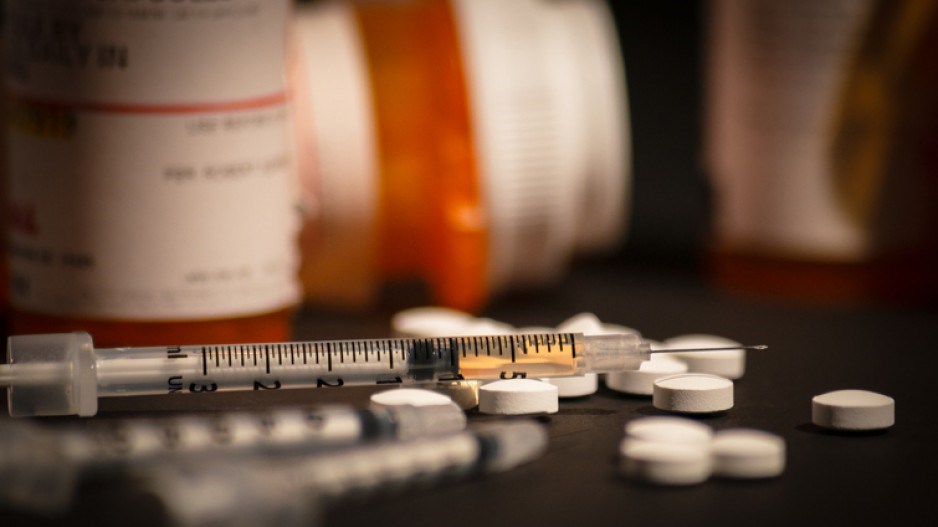British Columbia’s illicit fentanyl market is conservatively estimated at upwards of $300 million, according to a unique study by local criminologists and drug experts.
Dr. Martin Bouchard, a Simon Fraser University criminologist, and Dr. Michael-John Milloy, a research scientist at the British Columbia Centre on Substance Use, presented their findings to the Commission of Inquiry into Money Laundering in British Columbia Monday.
Bouchard told Commissioner Austin Cullen that the estimate of $200 million to $300 million being spent on the streets for fentanyl or fentanyl-included drugs or stimulants is conservative.
Their research report describes the figures as “plausible, yet imperfect calculations of total expenditures on fentanyl, ‘down’ (i.e., heroin contaminated with fentanyl), and stimulants (i.e., crack/cocaine, methamphetamine, etc.) laced with fentanyl.”
The report is based on studying cohorts of drug users, particularly in Vancouver’s Downtown Eastside neighbourhood, which has the highest prevalence of drug overdoses in the country.
The authors compiled data from 2017-18. They used baseline investigations of drug use by these cohorts in the DTES; inferred data on overdose deaths from the B.C. Coroners Service and drug prices from the Vancouver Police Department; and also examined court cases.
They estimated there is a minimum of 15,000 to 23,000 people in B.C. who have used or been exposed to fentanyl each year.
“We deem this range to be conservative, representing the floor estimate for fentanyl prevalence of use/exposure within the province,” the report states.
Bouchard, an expert in organized crime networks, explained to the commission that compiling exact data on drug use and illicit revenues for organized crime is difficult because users come and go and most won’t recall the exact amount they use nor the prices they pay. As well, users may not know they’ve consumed fentanyl.
However, the DTES has the most readily available and reliable data, and the researchers made their estimates there to extrapolate it to the province overall, Bouchard said.
“If we have a good idea of the number of people exposed in Vancouver, we can multiply that number by four …to get an idea of how many people are exposed to fentanyl as a whole,” he said. “We found more ways in which our scope was narrow and not broad.
“Each time you add an assumption you add uncertainty. We wanted to rely on what was most certain,” said Bouchard, who further explained that no such study has been done in B.C. or Canada.
“So we’re in the early stages, unfortunately; so we don’t have the raw data,” he said.
The commission is examining the scope of money laundering in B.C., particularly as it relates to provincial institutions and provincially regulated markets, including gambling and real estate.
“Although revenues do not equal profits, by estimating potential revenues from fentanyl, heroin and synthetic opioids in B.C., our report provides the potential contribution of this revenue source to money laundering within the province,” the report said.
“Fentanyl therefore seems to represent one important source of revenue for money laundering in B.C.”
The study only examines how much British Columbians are spending on fentanyl. It does not account for drug money potentially being imported from other provinces to be laundered through the local economy.
Laundering fentanyl proceeds is doubly concerning in B.C. granted people are dying of overdoses at record levels this year.
The number of overdose deaths in B.C. reached 1,386 between January and October of this year, according to new statistics released Wednesday by the BC Coroners Service. Fentanyl was detected in 1,146 of the victims. In 2018, a record 1,335 people died with fentanyl in their body (of 1,549 total illicit drug overdose deaths).
The commission has so far explored in depth one aspect of laundering proceeds of the fentanyl trade – that being through casinos – and how government regulators and law enforcement handled the situation.
In this scenario, organized criminals connected to China collect cash from the local sale of drugs, which are provided by Mexican and Chinese cartels.
The drug money is dispersed to Chinese gamblers via unregulated money service businesses. The loans are repaid via gambler’s bank account in China, thus skirting China’s capital export controls.
Experts suggest the criminal network in China then sends money and/or products to Mexico.
Known by some academics as the “Vancouver Model,” this scenario may theoretically be applied to any local product or service.
In effect, the fentanyl cash circulates through the B.C. economy in small amounts, and the foreign drug producers still get paid without having to ship cash over borders.
The import and export of products indirectly paid for by proceeds of crime is known as trade-based money laundering, which the commission will examine on Thursday.
The ‘Trade-Based Money Laundering Panel’ includes: Joel Gibbons, senior program adviser, Intelligence and Targeting Directorate, Canada Border Services Agency (CBSA); C/M Bryanna Gateley, intelligence analyst, Federal Serious and Organized Crime Unit, RCMP; and Sgt. Sushile Sharma, member, Federal Serious and Organized Crime Unit, RCMP.




